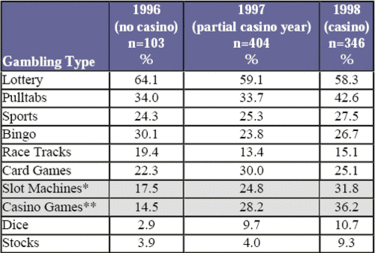The WAGER Vol. 8(42) – Drugs and Gambling: The Effect of a New Casino
There are many factors that communities must consider when deciding whether to open a casino and the protection of vulnerable populations (e.g., the elderly) from disordered gambling is typically high on the list. Research has shown that one particularly vulnerable population is substance abusers (e.g., Feigelman, Wallisch, & Lesieur, 1998; Rounsaville et al., 1991). This week the WAGER looks at a recent study that examined whether the introduction of a new casino affected the prevalence of problem gambling in a sample of treatment-seeking drug-dependent subjects in Ontario (Toneatto, Ferguson, & Brennan, 2003).
Toneatto, Ferguson and Brennan (2003) studied 853 (564 male) substance abusers consecutively admitted to residential drug treatment in Niagara Falls, Ontario during the 36 months following the introduction of the Niagara Casino. The casino opened on December 9, 1996. The authors compared the gambling behaviors of program entrants in the year the casino opened (1996; n=103), the year after the casino opened (1997; n=404) and at least one year after the casino opened (1998; n=346). In all three years, the authors asked participants to report on their gambling behaviors in the previous 12 months, creating three reporting groups: pre-casino, partial casino year, and post-casino. Enrollment in the treatment program was voluntary, and there were no specific inclusion or exclusion criteria for participation in the study. The mean age of study participants was 33.8 years (SD 8.8). All subjects completed the South Oaks Gambling Screen (SOGS, Lesieur & Blume, 1987) as part of the intake procedure. The intake assessment also collected demographic information and information about drug use and psychiatric problems.
The authors found that, in the year before the casino opened, subjects participated in fewer casino-type gambling activities (i.e., casino games and slot machines) in the past year than subjects in the following two years (see Table 1). The authors did not report the statistical tests for the significance of the differences, however, the WAGER staff used a chi-square test to confirm significance at p<0.01 and p<0.001 for the differences across years in the prevalence of playing slot machines and casino games, respectively. Participation in non-casino-type games did not differ significantly among participants by year. The overall effect of the new casino on disordered gambling behavior was less clear: the authors found that SOGS scores only increased by year for people who played card games, a form of gambling unrelated to the opening of the casino, initially suggesting the casino had a negligible effect on subjects’ reported gambling problems. However, among subjects who gambled at least weekly, individuals who reported participating in casino-type games scored significantly higher on the SOGS by year than subjects who played less frequently.
Table 1. Past-year subject participation in various types of gambling by year of admittance (adapted from Toneatto et al., 2003)
* p<0.01; ** p<0.001
There are several methodological limitations to this study. For example, although the authors observed increased participation in casino-type games among the study population (i.e., substance abusers) after the casino opened, they did not measure the extent of increased gambling in the general population. It is possible that, while the opening of a casino prompted increased casino gambling among the population at large, gambling among substance users was not different than gambling among other groups in the community. Further, it is possible that casino gambling was considered a novelty by subjects at the time of data collection, as the casino had only been in operation for two years when the study ended. This provides a possible explanation for increased play among the study participants. Moreover SOGS scores did not vary pre- and post-casino. This result suggests that increased casino play did not necessarily contribute to increased incidence of pathological gambling among substance users. The authors did observe increased SOGS scores by year when taking play frequency into consideration; however, these findings did not necessarily result from casino presence, as the authors also observed increased SOGS scores for frequent players of non-casino games. Finally, this was a cross-sectional study; therefore, changes in gambling behavior of individual subjects from pre- to post-casino were unknown.
This study reinforces the need for a continued focus on determining the effects of legalized gambling on vulnerable populations. Toneatto et al’s findings indicate that the introduction of casino gaming can present a potential threat to individuals with substance abuse problems; it is likely that this threat also exists for other populations that are considered “at-risk.” Whereas many current research studies analyze the broad risks posed by the legalization of gambling in specific communities, additional studies should focus on the differentiation between increased gambling behaviors and increased gambling problems within a community and the differential impact on population sub-groups. Such an approach could yield public outreach and education strategies capable of assisting those who are most at risk.
Comments on this article can be addressed to Tony Donato.
References
Feigelman, W., Wallisch, L. S., & Lesieur, H. R. (1998). Problem gamblers, problem substance users, and dual problem individuals: an epidemiological study. American Journal of Public Health, 88(3), 467-470.
Lesieur, H. R., & Blume, S. B. (1987). The South Oaks Gambling Screen (SOGS): A new instrument for the identification of pathological gamblers. American Journal of Psychiatry, 144(9), 1184-1188.
Rounsaville, B. J., Anton, S. F., Carroll, K., Budde, D., Prusoff, B. A., & Gawin, F. (1991). Psychiatric diagnoses of treatment-seeking cocaine abusers. Archives of General Psychiatry, 48(1), 43-51.
Shaffer, H. J., Hall, M. N., & Vander Bilt, J. (1997). Estimating the prevalence of disordered gambling behavior in the United States and Canada: a meta-analysis. Boston: Presidents and Fellows of Harvard College.
Toneatto, T., Ferguson, D., & Brennan, J. (2003). Effect of a new casino on problem gambling in treatment-seeking substance abusers. Canadian Journal of Psychiatry, 48(1), 40-44.
